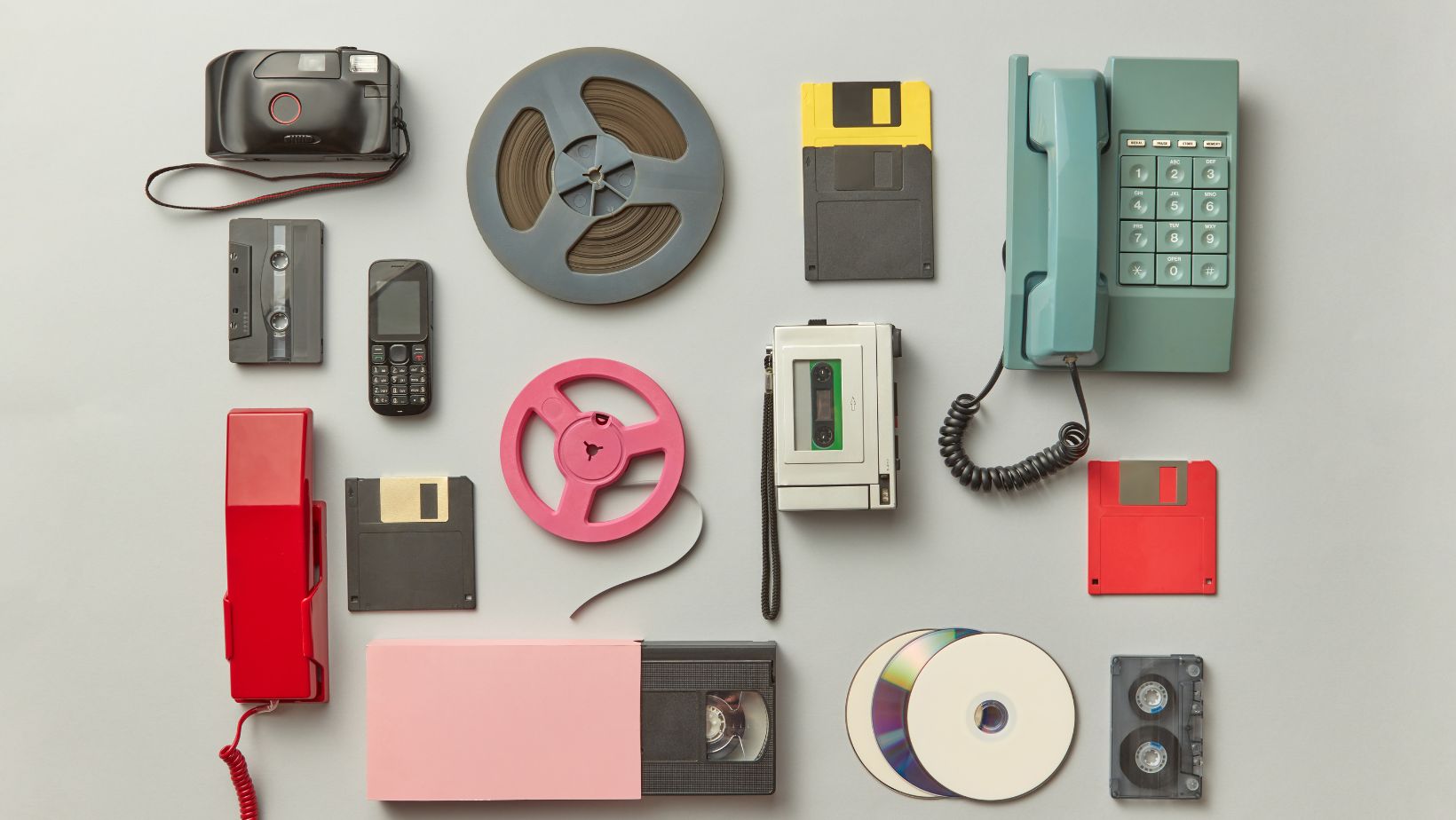Key Takeaways
- Technological Revolution: The 1980s marked a pivotal era with the introduction of personal computers and portable music players, setting the stage for the digital age.
- Cultural Shift: Gadgets became symbols of status and creativity, influencing daily life and social interactions through innovations like the Walkman and mobile phones.
- Iconic Devices: Key gadgets such as the Apple II, Motorola DynaTAC 8000X, and Nintendo Entertainment System (NES) transformed how people communicated, worked, and entertained themselves.
- Entertainment Evolution: Advances like VCRs and cable TV changed viewing habits, allowing individuals to enjoy recorded shows and new media channels on demand.
- Legacy of Innovation: The inventions of the 1980s continue to resonate today, laying the groundwork for modern technologies like smartphones and streaming services, and emphasizing personal expression.
The 1980s marked a revolutionary era in technology, where innovation transformed everyday life. From the rise of personal computers to the birth of portable music, this decade introduced gadgets that would shape the future. It was a time when the world began to embrace electronics, paving the way for the digital age.
As people navigated through the vibrant culture of the 80s, gadgets became symbols of status and creativity. Devices like the Walkman and the first mobile phones not only changed how people communicated but also how they experienced entertainment. The excitement surrounding these inventions fueled a fascination that continues to influence modern technology today.
Gadgets in the 80s
The 1980s saw a surge of innovative gadgets that transformed technology and culture significantly. Personal computers, such as the Apple II and IBM PC, entered homes, becoming central to daily activities and work. Graphical user interfaces (GUIs) popularized computer use, making technology accessible to non-technical users.
Portable music devices emerged, with the Walkman leading the way. Sony introduced the Walkman in 1979, but it became a defining gadget of the 1980s, allowing individuals to enjoy music on the go. The cassette format dominated this era, enabling people to create personal mixtapes, paving the way for a new avenue of self-expression.
Television technology advanced with the introduction of cable networks and VCRs. These allowed viewers to record shows and watch movies at their convenience. Popularity soared for devices like the VHS player, which significantly impacted how people consumed entertainment.
The advent of mobile phones also marked a shift in communication. Early mobile phones, though large and expensive, began to replace landlines for many. The Motorola DynaTAC 8000X, released in 1983, became the first commercially available mobile phone, showcasing the beginning of a wireless communication era.
Innovations like handheld calculators and gaming consoles contributed to the tech landscape. The introduction of the Nintendo Entertainment System (NES) in 1983 revived the gaming industry and captivated millions, reinforcing interactive entertainment’s cultural significance.
The gadgets of the 1980s played a crucial role in shaping modern technology, emphasizing both functionality and personal expression. These devices reflected a shift towards a more connected, digital lifestyle, laying the groundwork for future innovations.
Popular Gadgets
The 1980s introduced several groundbreaking gadgets that defined the era. These devices not only changed how people interacted with technology but also influenced cultural trends and personal lifestyles.
Personal Computers
Personal computers emerged as essential tools in the 1980s, notably with the launch of the Apple II in 1977 and the IBM PC in 1981. These devices featured user-friendly graphical interfaces, making computing accessible to a wider audience. The popularity of personal computers grew rapidly, with over 10 million units sold by 1983. Software advancements, particularly word processing and spreadsheet applications, enhanced productivity, as users began integrating computers into their daily routines. The rise of home computing fostered creativity, allowing individuals to design, write, and program with newfound ease.

Gaming Consoles
Gaming consoles transformed entertainment in the 1980s, culminating in the release of the Nintendo Entertainment System (NES) in 1985. The NES sold over 61 million units worldwide and popularized franchises such as Super Mario Bros and The Legend of Zelda. This console provided immersive gaming experiences through graphic improvements and diverse gameplay. Other notable systems included the Atari 2600 and Sega Master System, which expanded the gaming market, capturing the attention of children and adults alike. The gaming culture blossomed, leading to dedicated communities and competitive gaming.
Portable Music Players
Portable music players revolutionized how individuals consumed music. Sony’s Walkman, introduced in 1979, gained immense popularity in the 1980s, selling more than 150 million units by 2012. This compact cassette player allowed users to enjoy music on the go, creating a more personal listening experience. The innovation led to the emergence of mixtapes, which became a popular means of self-expression. The introduction of the CD Walkman in 1984 further enhanced audio quality, cementing the device’s status as a cultural icon. These portable music players laid the groundwork for the evolution of digital music consumption in future decades.
Iconic Gadget Brands
The 1980s witnessed the emergence of several iconic gadget brands that defined the decade’s technological landscape. These companies not only influenced consumer electronics but also set the stage for future innovations.
Apple
Apple established itself in the 1980s with the launch of the Apple II, which became a bestseller and sold over 6 million units by 1993. The Apple II featured a pioneering graphical user interface and affordability, attracting both personal and educational markets. This model demonstrated the potential of personal computing, leading to the creation of software ecosystems tailored to enhance productivity and creativity.
Sony
Sony revolutionized portable music with the introduction of the Walkman in 1979, but it became a cultural icon throughout the 1980s. The Walkman allowed users to listen to music discreetly, promoting personal music experiences. By 1986, Sony had sold over 50 million Walkmens globally, influencing how people engaged with music and fostering the mixtape phenomenon. Sony’s commitment to quality sound and innovative design solidified its status as a leading electronics brand.
Casio
Casio significantly impacted the 1980s with its diverse range of gadgets, including calculators and keyboards. The Casio FX-7000G, released in 1985, emerged as the first graphing calculator, enhancing mathematical problem-solving capabilities. Concurrently, the Casio CZ series synthesizers transformed music production, incorporating digital technology into accessible instruments. Casio’s innovative approach appealed to both students and musicians, reinforcing its reputation as a major player in personal electronics.
Impact on Culture
The gadgets of the 1980s significantly influenced culture, marking a shift in lifestyles and entertainment. These innovations not only changed daily routines but also shaped social interactions and creative expressions.
Influence on Lifestyle
Gadgets like personal computers and portable music devices transformed lifestyles. Personal computers facilitated work and communication, introducing applications that streamlined daily tasks. As over 10 million IBM PCs entered homes by 1983, individuals gained access to tools that increased productivity and organization. The Sony Walkman’s release in 1979 altered music consumption, allowing users to curate personal playlists and enjoy music during commutes and outdoor activities. The popularity of cassette mixers encouraged creativity in music selection and personal identity. Additionally, handheld calculators simplified math tasks, enhancing academic and professional efficiency. Overall, these gadgets fostered a culture of convenience and self-expression.
Role in Entertainment
The 1980s saw a dramatic evolution in entertainment, driven by technological advancements. The Nintendo Entertainment System (NES) became a household staple, with over 34 million units sold in the U.S. by 1990, introducing immersive gaming experiences and popular franchises that shaped childhoods. Meanwhile, cable television expanded viewing options and introduced channels that catered to specific interests, such as MTV revolutionizing music consumption. VCRs allowed viewers to record shows, creating a new dynamic in content consumption. These developments contributed to a culture that embraced instant access to entertainment, reshaping social gatherings and family time around shared viewing and gaming experiences.
Legacy of 80s Gadgets
The legacy of 1980s gadgets continues to resonate in modern technology, exemplifying innovation and cultural shifts. Personal computers established the foundation for today’s digital landscape. The Apple II and IBM PC demonstrated user-friendly interfaces, making computing accessible to millions. Their sales figures, exceeding 10 million units by 1983, indicate a significant shift towards technology integration in daily life.
Portable music devices, particularly the Sony Walkman, revolutionized how individuals engaged with music. With sales surpassing 50 million units by 1986, the Walkman became a symbol of personal expression. This gadget allowed users to enjoy customized playlists and influenced the evolution of portable audio technology, paving the way for future devices like MP3 players and smartphones.
Gaming consoles, notably the Nintendo Entertainment System (NES), transformed entertainment culture. The NES’s immersive experiences brought families together and pushed the boundaries of interactive entertainment. Popular franchises, launched in the 80s, still captivate players today, solidifying the console’s impact on the gaming industry and establishing a cultural legacy.
Television advancements also played a critical role in shaping the media landscape. Cable networks and VCRs enhanced viewer autonomy, leading to a culture centered around personalized content consumption. These innovations laid the groundwork for streaming services and on-demand entertainment, shifting how audiences experience media.
The influence of 80s gadgets extended beyond leisure activities. Handheld calculators optimized academic and professional tasks, while the emergence of mobile phones, with early models like the Motorola DynaTAC 8000X, marked the start of mobile communication. This shift gradually phased out traditional landlines, as portable devices became essential for connectivity.
Overall, the gadgets from the 1980s set the stage for a technology-driven society. They showcased the intersection of functionality and personal expression while laying the groundwork for future advancements. The impact of these devices remains evident in today’s tech landscape, reflecting their importance in modern history.
Catalysts For Change That Shaped Everyday Life
The gadgets of the 1980s were more than mere tools; they were catalysts for change that shaped everyday life. They transformed communication entertainment and personal expression in ways that still resonate today. With each innovation from personal computers to portable music devices a new era began.
These gadgets not only introduced groundbreaking technology but also created a cultural shift that influenced how people interacted with the world. The legacy of the 80s gadgets continues to inspire modern advancements reflecting a time when technology truly began to integrate into daily life. The impact of this decade serves as a reminder of the power of innovation in shaping society.


